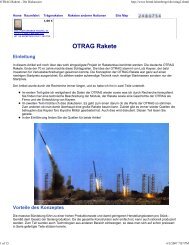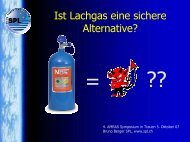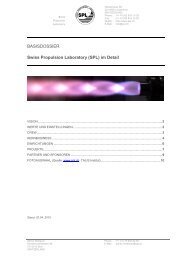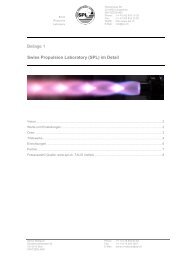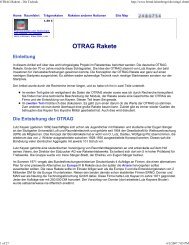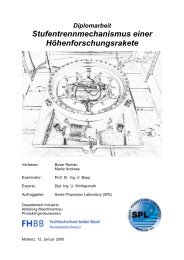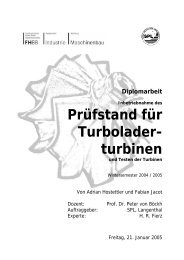You also want an ePaper? Increase the reach of your titles
YUMPU automatically turns print PDFs into web optimized ePapers that Google loves.
A controller in the pitch and yaw axis was targeted by throttling individual thrust engines.<br />
An engine failure is met by the shut down by the focal point symmetry located engine. A<br />
disadvantage of this approach is that retained by the reactors and switching off of engines<br />
larger quantities of fuel in the tanks, which of the other engines can not be used. They<br />
thus increase the empty weight considerably. The roll control is considered first, the<br />
engines of the outermost ring at 10 degrees to the thrust axis to install. A reduction of the<br />
thrust of one engine then causes a rolling of the whole rocket. Later we took an additional<br />
cold-gas system in the eye.<br />
No text to roll the tanks allow a staging by the next stage of rolling out the scaffolding<br />
surrounding the stage out. , the respective upper stage by 5 runs per CPMR (module) to<br />
the respective lower level based, so they "slip" is not down but up at ignition start out.<br />
The separation takes about 2 seconds.<br />
There is no Vorbeschleunigungstriebwerke, which earn a start in zero gravity, the fuel on<br />
the ground. Since the first furfuryl alcohol in the combustion chamber must flow, the<br />
stage will be ignited hot, ie The upper stage will be ignited, while the lower one is still in<br />
operation. The staging was therefore not when the fuel is exhausted, but the rocket had<br />
reached a predetermined speed.<br />
Over the last step is a central computer that has like other missiles on the object to control<br />
the rocket. He should have a gyroscopic system to detect the accelerations. This was used<br />
to calculate the speed and location of the rocket. The control was carried out by a<br />
conventional program, which directs the rocket to a predetermined target trajectory. The<br />
engine controls were driven by a 600 channel radio transmitter / receiver. Today Kayser<br />
would use in their own words for this WLAN. The first and second stage should be<br />
operated until the fuel is exhausted. This should be possible accurately to 0.1%,<br />
according to Kayser. The third stage is switched off when the desired final speed. This<br />
should be possible with an accuracy of 0.01 seconds.<br />
Test flights of the smaller versions have been controlled by the program and were<br />
stabilized aerodynamically. Interference torques about the roll axis are considered<br />
because of the high Kayser Bausymmetrie the bundled modules to be very low. They<br />
should be compensated for by a tangential thrust cold-gas system in each stage<br />
For the development of a missile with 2 t GTO payload would have <strong>OTRAG</strong> used about<br />
500 million marks, or about a quarter of the Ariane development costs. Such a support<br />
should be developed within 10 years. Later, the <strong>OTRAG</strong> employ up to 2,000 people<br />
directly and save 40,000 jobs in supplier companies. If the rocket <strong>OTRAG</strong> become truly<br />
successful, it would have been certainly the most scalable and most cost carrier.<br />
Variants of the <strong>OTRAG</strong> Launch Vehicle<br />
As already explained, it would be possible to launch any payload through an appropriate<br />
combination of modules. Kayser has submitted the following standard sizes. They differ



